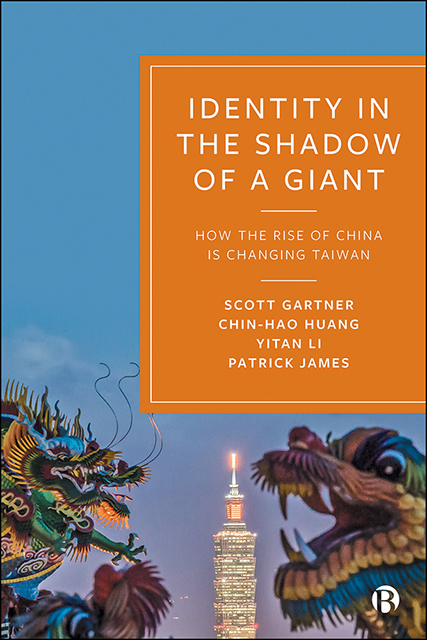Book contents
- Frontmatter
- Dedication
- Contents
- List of Figures and Tables
- About the Authors
- Acknowledgements
- Preface
- 1 Identity in the Shadow of a Giant: How the Rise of China Is Changing Taiwan
- 2 Taiwan in Historical Perspective
- 3 The Problématique of Taiwanese Identity
- 4 Theorizing about Identity, Change in Capabilities and Dyadic Relations: An Approach Based on Analytic Eclecticism and Systemism
- 5 Elite Reflections
- 6 Popular Reflections (Survey I)
- 7 Factors Influencing Identifying Only as Taiwanese: A Layered Empirical Approach (Survey II)
- 8 A New Vision of Taiwanese Identity, the Rise of China, Cross-Strait Relations and the United States in Northeast Asia
- Appendix A Research Interview Questions, September–October 2015
- Appendix B Taiwanese Identity and the Rise of China: Survey Questions, 27 October 2015
- Appendix C Taiwan National Security Survey by Emerson Niou
- References
- Index
2 - Taiwan in Historical Perspective
Published online by Cambridge University Press: 15 April 2023
- Frontmatter
- Dedication
- Contents
- List of Figures and Tables
- About the Authors
- Acknowledgements
- Preface
- 1 Identity in the Shadow of a Giant: How the Rise of China Is Changing Taiwan
- 2 Taiwan in Historical Perspective
- 3 The Problématique of Taiwanese Identity
- 4 Theorizing about Identity, Change in Capabilities and Dyadic Relations: An Approach Based on Analytic Eclecticism and Systemism
- 5 Elite Reflections
- 6 Popular Reflections (Survey I)
- 7 Factors Influencing Identifying Only as Taiwanese: A Layered Empirical Approach (Survey II)
- 8 A New Vision of Taiwanese Identity, the Rise of China, Cross-Strait Relations and the United States in Northeast Asia
- Appendix A Research Interview Questions, September–October 2015
- Appendix B Taiwanese Identity and the Rise of China: Survey Questions, 27 October 2015
- Appendix C Taiwan National Security Survey by Emerson Niou
- References
- Index
Summary
Overview
This chapter focuses on Taiwan in historical perspective. The goal is to review the most important aspects of the evolution of Taiwanese identity, cross-Strait relations, the rise of China, the role of the US, and how these matters are connected to each other. These lines of inquiry capture the essential components for an account of the likely pathway for cross-Strait relations, which in turn obviously have reverberations that further impact on cause and effect within the regional system of Northeast Asia and even beyond. Thus, emphasis is placed on a review of historical events that are believed to be important for the development of a comprehensive understanding of the situation today.
This chapter proceeds in seven additional sections. The second section moves forward from early history to the arrival of the Japanese in 1895. The third section covers the era of Japanese rule from 1895 to 1945. The initial decades of Nationalist rule are reviewed in the fourth section from 1945 to 1979. Corresponding to the 1980s, the Taiwanese economic miracle and identity-related developments appear in the fifth section. The sixth section – an era of one country with many problems – covers the 1990s. The seventh section focuses on key interactions involving the DPP in power vis-à-vis the US and PRC in the new millennium. The eighth and final section sums up the history of Taiwan as presented in this chapter.
Early history
Taiwan, also known as Formosa, is an island about 160 kilometres (100 miles) from the Asian coastline. With mountainous territory and a subtropical climate and diverse ecosystem, the approximately 36,000 square kilometre (14,000 square mile) island is well-suited to human habitation, which goes back a long way in history. Aboriginal groups with Oceanic and Chinese origins, along with others about whom less is known, can be traced back to prehistoric times (Knapp, 2007: 5–9). A short-lived Dutch colonial settlement in the 17th century brought with it intensive agriculture to complement the hunting, gathering, fishing and small-scale farming that existed already (Knapp, 2007: 11). Ming General Zheng Chenggong, also known as Koxinga, expelled the Dutch from Taiwan in 1662 (Spence, 1999: 54; Sheng, 2001: 9; Knapp, 2007: 13). Chinese dynasties then ruled the island for over two centuries.
- Type
- Chapter
- Information
- Identity in the Shadow of a GiantHow the Rise of China is Changing Taiwan, pp. 21 - 42Publisher: Bristol University PressPrint publication year: 2021



